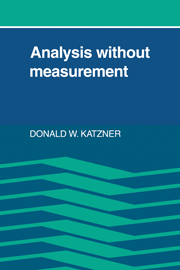Book contents
- Frontmatter
- Contents
- Preface
- Dedication
- 1 Introduction
- 2 Notes on measurement
- Part I Theoretical methods
- Part II Applications to theoretical problems
- Part III Empirical verification
- 12 Statistical background
- 13 Empirical relations among variables
- 14 An empirical application: occupational preferences and the quality of life
- 15 Getting on without measures
- Index
13 - Empirical relations among variables
Published online by Cambridge University Press: 04 August 2010
- Frontmatter
- Contents
- Preface
- Dedication
- 1 Introduction
- 2 Notes on measurement
- Part I Theoretical methods
- Part II Applications to theoretical problems
- Part III Empirical verification
- 12 Statistical background
- 13 Empirical relations among variables
- 14 An empirical application: occupational preferences and the quality of life
- 15 Getting on without measures
- Index
Summary
The last chapter considered, in part, statistical tests for the existence of relations among variables. These tests are based on how observations of the variables in question fit together. But in many situations (e.g., prediction) merely to know that statistical evidence supports its existence is not enough: Some knowledge of the nature of the relation itself is essential. The only empirical way of approaching such a problem is to ask what sorts of relations best fit the observations at hand. When meaningful numbers are available the usual technique is to assume that the relation has a certain form, say, linearity, and then estimate its parameters. If according to some acceptable criterion the fit turns out to be “good,” the assumed form is taken as a reasonable approximation of reality. Parallel procedures in the absence of ratio, interval, and ordinal measures are of interest here.
As remarked earlier, empirical relations are obviously capable of detection even in the absence of measurement. It is only necessary to observe that, under appropriate conditions, certain values of, say, (x1,…,xK) arise with certain values of (p1,…,pM). Once such information is obtained, subsequent investigation might include the drawing of structural inferences and the formulation of predictions. This chapter explores these possibilities.
Even without ratio, interval, and ordinal scales, introduction of numbers in the form of dummy variables is often legitimate in order to facilitate analysis. Recall (Section 2.2), any typology or classification scheme permits nominal measurement. That is, given a set A” and some decomposition of X into mutually exclusive and exhaustive subsets, Sv, the objects of X can be assigned real numbers such that within each Sv, all elements receive the same numerical value.
- Type
- Chapter
- Information
- Analysis Without Measurement , pp. 253 - 274Publisher: Cambridge University PressPrint publication year: 1983



